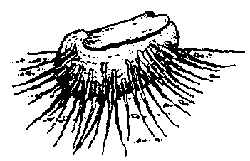| Rhynchonelliformea | ||
| Brachiopoda | Productida |
| Metazoa | |||
Specialization within some groups resulted in truly bizarre variations on the basic brachiopod theme, including some forms that mimicked corals. Other species were infaunal or quasi-infaunal, living partially or completely buried in sediment, like bivalves. In many forms the pedicle is lost when adult, the individuals being held in position by cementation or by spines attached to the substrate.
(Late Ordovician--Late Permian/Early Triassic)

The Chonetids are the earliest and least derived representatives of the Productida, and can be considered ancestral to later forms. They first appear in the Late Ordovician, but the group only became more common later on
Some Devonian chonetids have unusually large spines and coarse costae; others are distinguished by denticles on the hinge margin and strong convexity of the pedicle valve. Carboniferous and Permian strata often contain useful index fossils belonging to this group. One of the best known is Mesolobus, distinguished by longitudinal corrugations of the mid-portion of the valves; it is confined to Middle Pennsylvanian
Early Devonian-Late Permian/?Early Triassic)

The productids differs from their chonetid forebears in having much greater convexity of the pedicle valve and generally a more concave brachial valve. There are also a varying number of spines (which may be short or long) distributed over the surface
Productids were fairly rare during the Devonian, but become extremely numerous in the Carboniferous and Permian periods. Two main shell types are distinguished: in one, the surface is marked chiefly by longitudinal fine to coarse ribs, with few spines; in the other, spines are very numerous and costae are lacking or inconspicuous. Some members of the rib-marked group have evenly spaced concentric corrugations on the posterior part of both valves so as to produce a reticulate pattern; and the interior of the brachial valve bears looped ridges which probably are the impressions left by the lophophore.
Among the Early Carboniferous Mississippian costate productids, Gigantoproductus is the largest brachiopod known, attaining a width of approximately 30 cm.
The noncostate productids have shells covered by abundant obliquely disposed spines, these project backward from the posterior edge of both valves. These it would seem supported the animal in the substrate, functioning as a sort of "snowshoe," supporting and stabilizing the organism on soft muds, or allowed it to cling to seaweed or other objects

Some of these long-spined forms are characterized by unevenness in the arrangement of the spines, others by very regular concentric rows of spines, and a Permian genus (Waagenoconcha) has spines arranged in curved, regularly intersecting oblique rows.
The anterior edges of productid valves were sharply angled upward in a flange. This flange may have been all that emerged above the sediment. The productids colonized a quasi- infaunal or almost buried (and hence protected) mode of life, one of the few brachiopod groups to imitate a bivalve (clam) lifestyle

The Strophalosiidines were a very strange group of brachiopods that adopted a coral-like existence. They were attached to the bottom by a cone-shaped pedicle valve, with the upper valve covering the cone like a pot lid. The unusual brachiopod Prorichthofenia from the Permian of Texas is one of these unusual conical forms. Superficially, the pedicle valve resembles Paleozoic horn coral and living solitary scleractinian corals. It is held in an upright position by its anchorage of outspread spines. The brachial valve is a lid-like structure which articulates with the pedicle valve at a level well below the shell edge. Near the margins of each valve on their inner side, spines are arranged in alternating position, in such a manner that when the valves are partly open, they protect the entrance to the shell interior. Some species even have a lacelike calcareous grill that arches over the brachial valve, and in these forms the inner spines are lacking.
Like the Rudist bivalves, the Richthofenioidea mimicked corals, and indeed formed large reefs. Individuals commonly grow together in clusters; and it is though that, like corals, some strophomenids bore photosynthetic algae inside their tissues that helped to supply them with food.

References:
Moore, Lalicker and Fischer, Invertebrate Fossils
 Brachiopoda main page |